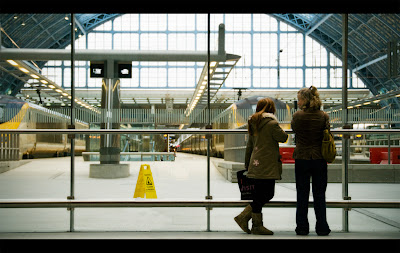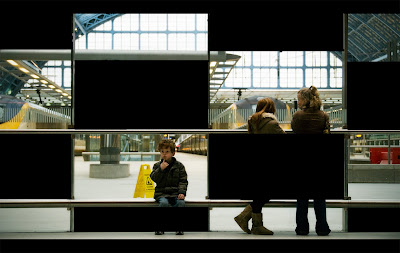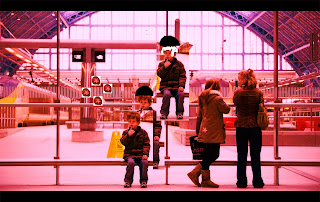Wednesday, March 26, 2008
Thursday, February 21, 2008
A great story on the importance, and difficulties, of continuity editing
You can listen to this story on NPR.ORG.
When Continuity Counts, Call a Script Girl — Er, Guy
Morning Edition, February 21, 2008 · Next time you see The Wizard of Oz, notice how Dorothy falls into a muddy pigpen early in the film. Somehow, when she's rescued, her dress is spotless.
A similar "Huh?" moment occurs in The Untouchables. As Kevin Costner tries to persuade Sean Connery to help him fight the mob, Connery's shirt collar mysteriously flaps open and shut throughout the conversation.
And in Pretty Woman, Julia Roberts munches on a breakfast croissant that, abracadabra, turns into a pancake.
Movie goofs like these are the ultimate responsibility of the script supervisor — the guru of continuity on a movie set.
Tuesday, February 19, 2008
Thursday, February 14, 2008
VOTE!
Wednesday, February 13, 2008
Tuesday, February 12, 2008
Hazy Dream
Monday, February 11, 2008
Wednesday, February 6, 2008
Caution... Cleaning in Progress
 My entry into the contest. With all cool artwork, it's the title that matters:
My entry into the contest. With all cool artwork, it's the title that matters:"Caution, Cleaning in Progress."
The Soviets perfected the art of airbrushing out of photos people who were once loyal Bolsheviks but, crazily, it turned out they were ACTUALLY Enemies of the People (Враг народа)... I have a great photo of Nikolai Ezhov (head of the Secret Police during the Purges) and Stalin and other Commie Cronies walking along the Moskva-Volga channel. And then the same photograph, with Ezhov magically obliterated. Stalin looks as though he's talking to himself.
Communist art.
Wednesday, January 30, 2008
First class project: Edit this photo!
First, everyone should vote on which photo we'll edit. Just vote in the comments to this post. I'll announce the photo NEXT MONDAY (February 4). The edited photo is due next Wednesday (February 6).
Some quick replies to questions you haven’t even asked yet…
1) Does this count? Will it affect my grade? Ah. Any teacher’s favorite question. Yes, it will affect your grade if you DO NOT DO IT. But if you submit SOMETHING, you’ll get full credit for the project. (It will be part of the 10% “Project” line in the grading rubric.)
2) Do I have to do this? Yes. But make of it what you want. Five minutes or five hours. Of course, we’ll all think you’re lazy and uncreative if you don’t come up with something cool. But you can live with that, right?
3) What photo are we going to edit? Let’s vote. I put three photos that I thought were pretty rich in potential (they hadn’t been edited much, they had lots of foci, they were interesting…) on the blog (see the link above). We'll choose one.
4) But I don’t have the software! Oh, come on… Download a copy of Photoshop for a trial, or use the free program Picasa, or find a computer on campus with editing software… Or type “edit photos” into Google and you’ll find sites like http://fotoflexer.com/. Or, be REALLY radical and do it the “old-fashioned way”: paper, scissors, another camera (photos of photos!), pebbles, construction paper, matches (hey, Vertov did it!)…
5) How do I submit my entry? On the blog, of course: http://kino-studies.blogspot.com/. You’ll have to have posting privileges – just send me your preferred email address, gmail account, or blogger account. (Students in Elementary Russian should use the same account they use in Russian language.)
Monday, January 28, 2008
A few videos to demonstrate ideas from Part IV (Film Style) of Film Art
A great example of rack focusing:
A tutorial on three-point lighting:
The classic long take, mobile framing from Touch of Evil (see p. 287ff in your book). Start the video around 1 minute. You'll see most of the repertoire of framing -- tracking (dolly) shots, crane shots, pans and tilts, rack zoom, and lots of interesting angles, and shifting distances (from long shots to close-ups). There are a number of joins/editing cuts, starting around minute 4. But otherwise, it's a classic of the long take, though we'll see a far more interesting and better use of the technique (I think) in I Am Cuba (Я Куба/Soy Cuba):
For the classic, more or less first use of cross-cutting, watch the last three or four minutes of The Battle at Elderbush Gulch by D. W. Griffith. Notice also his clever use of framing at 18:23 (the dilating iris of the camera) as the cavalry arrives. The cutting back and forth among the menfolk inside the house, the womenfolk, the injuns, the cavalry... Great, un-politically correct fun.
Monday, January 21, 2008
What photograph are we going to edit?



You pick Use the comments section to vote. These are all from Flickr, all of them with Creative Commons licensing. I'll send the class a full-sized, higher-resolution version of the photograph for editing -- don't use these small formats.
Oh, here's a pretty straightforward and practical overview of all the things you can do with Photoshop. (Other photo-editing programs have the same or similar functionality.)



















